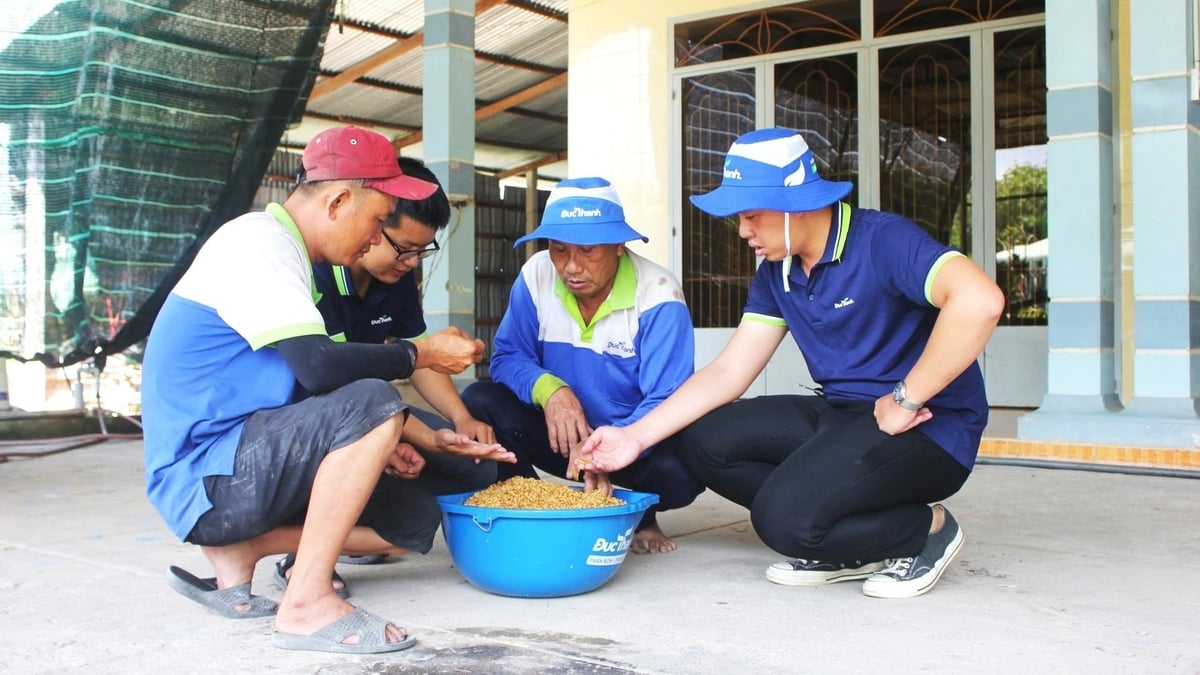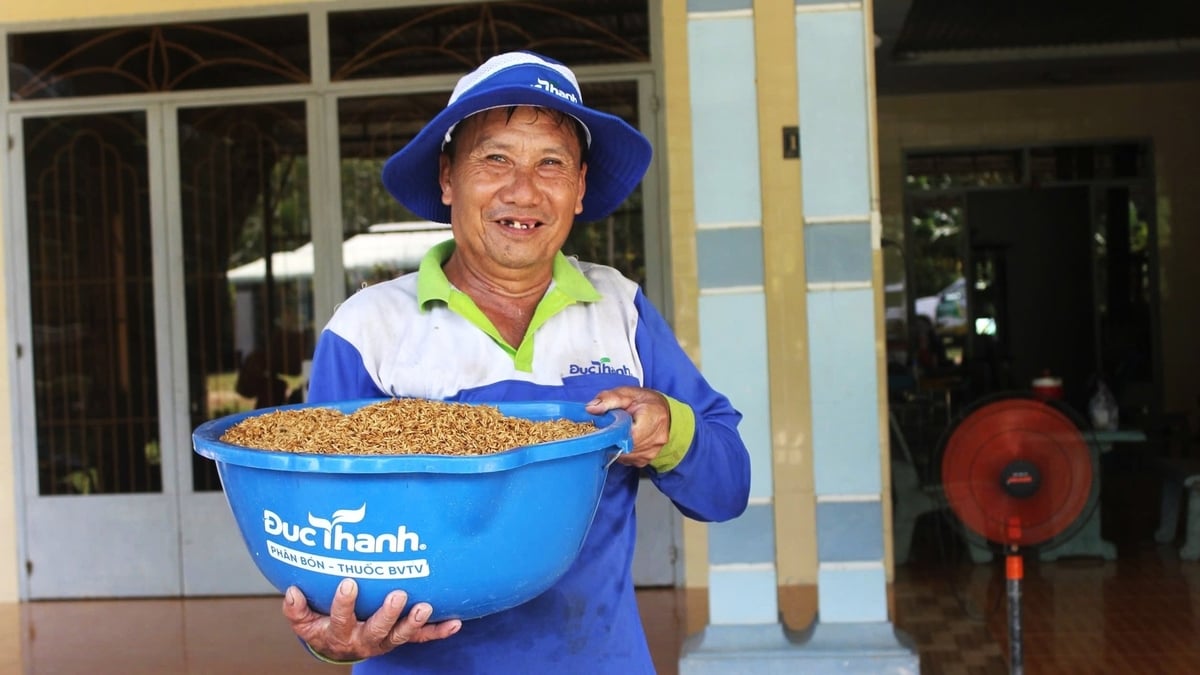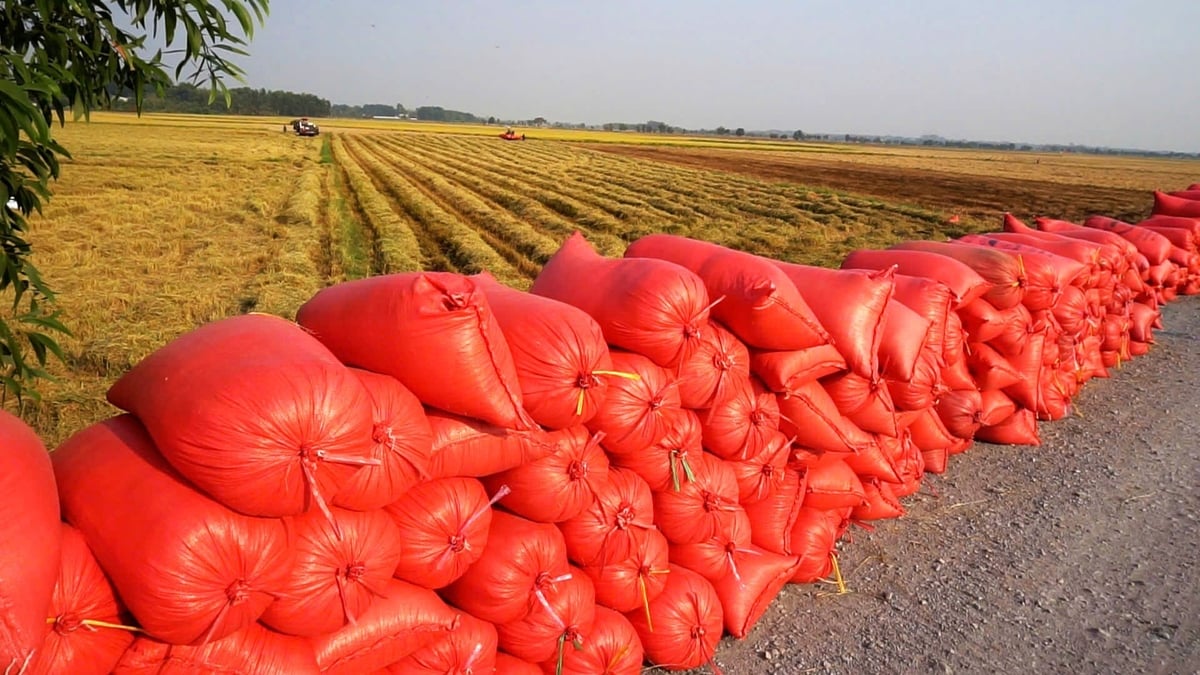December 5, 2025 | 21:26 GMT +7
December 5, 2025 | 21:26 GMT +7
Hotline: 0913.378.918
December 5, 2025 | 21:26 GMT +7
Hotline: 0913.378.918
The rice fields of Ap Truong, Hao Duoc commune, Chau Thanh district, Tay Ninh, are blanketed by a mild golden sun as the spring-summer crop ends. With his sickle in hand and a relaxed expression, Mr. Nguyen Van Co rushes. For him, each season marks a moment of reflection on positive changes, in methods, mindset, and the future of his land.

Agricultural engineers of Duc Thanh Company guide farmers in evaluating the quality of rice grains. Photo: Tran Phi.
"In the past, the practice of traditional rice farming involved the burden of all of the elements, including pests, prices, and weather, which we could not control." It was tough and not very profitable,” Mr. Co recalls. His voice drops, then brightens again: “Ever since I joined the linkage model with the company, my life has changed significantly.”
“The biggest benefit isn’t just yield or profit, it’s peace of mind. Upon completion of the harvest, an individual arrives to retrieve it and promptly reimburses me. It’s such a relief,” he shares.
This transformation was initiated by the close partnership with Duc Thanh Co., Ltd., a local enterprise that opted to farm alongside growers rather than solely serving as a buyer. They dispatch agricultural engineers to the fields to offer step-by-step guidance and high-quality rice seedlings, eco-friendly bio-fertilizers, and plant protection products.

Mr. Nguyen Van Co, a pioneer farmer in Tay Ninh participating in the clean rice production model to reduce emissions. Photo: Tran Phi.
“At first, it was unfamiliar. But then I realised that using the right techniques made the plants healthier, less prone to pests, with fewer pesticide sprays needed. Costs went down, and yields went up,” Mr. Co nods. His field has experienced a nearly 30% increase in production, from 13 bushels per sao (a traditional unit of area) to 17. Profits are enhanced after the reduction of expenses for each season. The company has resolved the long-standing concern regarding market access by purchasing the harvest directly at a consistent price.
Mr. Co is not the only farmer in the area utilizing this low-emission pure rice production model. In the initial phases, the government provides farmers security by covering approximately 30% of the costs, equivalent to 3 million VND per hectare. This allows them to experiment with this new strategy.

The fields in Hao Duoc are changing dramatically thanks to the application of clean rice farming methods. Photo: Tran Phi.
The new cultivation model is transforming the agricultural environment and economy. Farmers are transitioning from chemical fertilizers to organic and microbial fertilizers. Straw is no longer burnt; it is reused. Pesticide use is meticulously evaluated. Consequently, there has been a substantial decrease in greenhouse gas emissions, including CH₄ and N₂O.
Duc Thanh Co. is investing in a rice processing facility that complies with export standards, establishing a controlled value chain. As quality is managed from input to output, the rice achieves higher prices and obtains access to green and clean markets with strict standards.
According to Mr. Nguyen Dinh Xuan, Director of the Department of Agriculture and Environment of Tay Ninh, this is a strategic direction the province is pushing forward: “The farmer-business-government linkage does more than improve incomes, it lays the foundation for green, sustainable agriculture. We will continue to support farmers, especially during the initial transition.”
These first steps are reviving the fields of Hao Duoc. Today's green rice paddies represent hope and vitality. Farmers are no longer isolated in their fields as they construct a new agricultural value chain.
Rice farming is responsible for about 10% of global agricultural greenhouse gas emissions, with Vietnam—while being the world’s second-largest rice exporter—also ranking among the top emitters of methane from rice cultivation. Traditional practices such as continuous flooding and heavy use of chemical fertilisers have long contributed to this environmental burden. However, transitioning to low-emission techniques like alternate wetting and drying, the use of organic or microbial fertilisers, and reducing post-harvest straw burning can help cut emissions by 30–50% per hectare.
Translated by Linh Linh

(VAN) After three years, Project FST/2020/123 collected approximately 3,000 insect specimens, classified them into about 50 morphological groups, and identified around 40 species, including several new species.
/2025/12/01/0509-2-175427_206.jpg)
(VAN) Emission-reducing coffee areas in Lam Dong have entered the new crop with stable yields, improved quality, and a remarkably enhanced cultivation environment.

(VAN) The Institute of Agricultural Sciences for Southern Vietnam (IAS) marked its 100th anniversary in Ho Chi Minh City, celebrating a century of growth as a leading institute contributing significantly to Viet Nam’s agricultural development.

(VAN) An increasing number of livestock farms are using biogas generators to create a source of renewable electricity, helping to save costs and mitigate environmental pollution.

(VAN) Small changes in rice cultivation, from irrigation methods and straw collection to input management, are paving a new way for Vietnam's agriculture in the journey toward emission reduction.

(VAN) With the project of converting biogas into renewable electricity, Australia is both helping pig farms reduce their energy costs by up to 25% and contributing to environmental protection.
![Hue aims for Net Zero: [1] Initial steps from green transportation](https://t.ex-cdn.com/nongnghiepmoitruong.vn/608w/files/huytd/2025/11/28/0853-anh-6-giao-thong-xanh-hue-094717_940-153724.jpg)
(VAN) For sustainable development, Hue City is implementing many solutions to promote green transportation, which is an important initial step on the journey to building a Net Zero Hue.